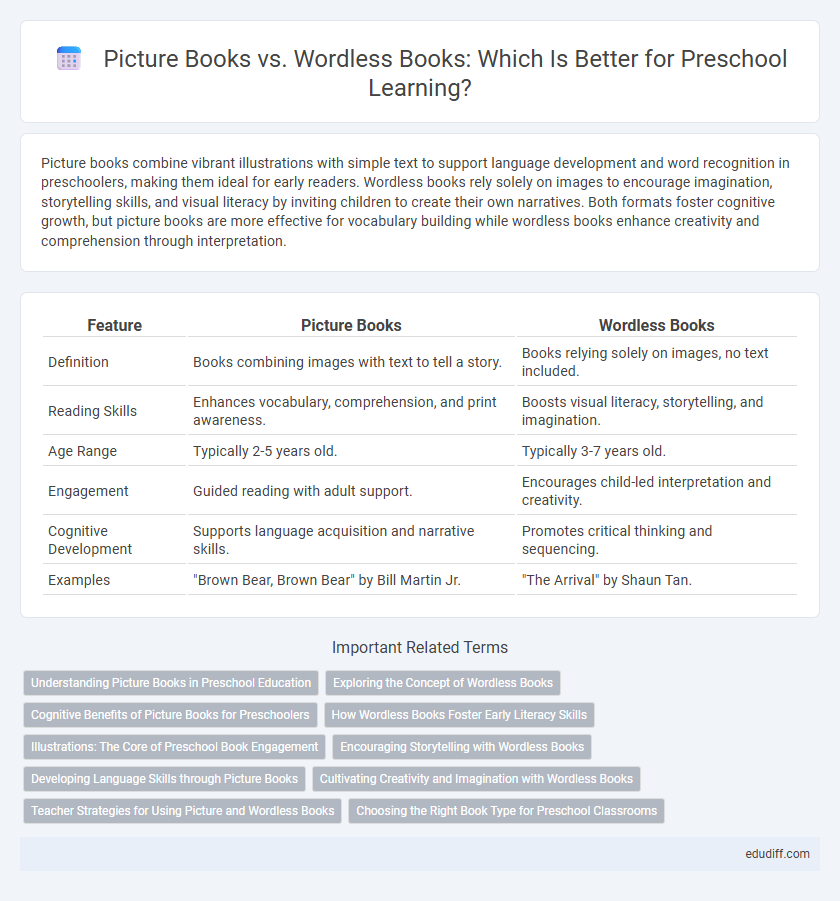Picture books combine vibrant illustrations with simple text to support language development and word recognition in preschoolers, making them ideal for early readers. Wordless books rely solely on images to encourage imagination, storytelling skills, and visual literacy by inviting children to create their own narratives. Both formats foster cognitive growth, but picture books are more effective for vocabulary building while wordless books enhance creativity and comprehension through interpretation.
Table of Comparison
| Feature | Picture Books | Wordless Books |
|---|---|---|
| Definition | Books combining images with text to tell a story. | Books relying solely on images, no text included. |
| Reading Skills | Enhances vocabulary, comprehension, and print awareness. | Boosts visual literacy, storytelling, and imagination. |
| Age Range | Typically 2-5 years old. | Typically 3-7 years old. |
| Engagement | Guided reading with adult support. | Encourages child-led interpretation and creativity. |
| Cognitive Development | Supports language acquisition and narrative skills. | Promotes critical thinking and sequencing. |
| Examples | "Brown Bear, Brown Bear" by Bill Martin Jr. | "The Arrival" by Shaun Tan. |
Understanding Picture Books in Preschool Education
Picture books in preschool education combine vivid illustrations with simple text, fostering early literacy by connecting words to images and enhancing vocabulary development. These books support narrative skills and comprehension by providing context cues through pictures that guide children in understanding story structure. Educators use picture books to promote language acquisition, imagination, and critical thinking, laying the foundation for effective communication and reading readiness.
Exploring the Concept of Wordless Books
Wordless books offer preschoolers unique opportunities to develop narrative skills by interpreting illustrations without text, fostering creativity and visual literacy. Unlike picture books that combine images and words, wordless books encourage children to construct their own stories, enhancing language development and imagination. These books support critical thinking and communication as children describe scenes, sequence events, and share personalized interpretations with peers or caregivers.
Cognitive Benefits of Picture Books for Preschoolers
Picture books enhance preschoolers' cognitive development by combining visual and verbal cues that support language acquisition, vocabulary expansion, and narrative comprehension. The integration of text with illustrations promotes early literacy skills by helping children associate words with images and understand story structure. This dual coding of information strengthens memory retention and critical thinking, laying a foundation for effective reading proficiency.
How Wordless Books Foster Early Literacy Skills
Wordless books enhance early literacy skills by encouraging children to develop narrative skills through visual storytelling, strengthening comprehension and imagination without relying on text. These books promote active engagement as children interpret images, sequence events, and infer meaning, which builds foundational skills for reading and communication. Preschool educators leverage wordless books to support vocabulary growth, critical thinking, and oral language development in a natural and interactive way.
Illustrations: The Core of Preschool Book Engagement
Illustrations in preschool books serve as the primary tool for cognitive and emotional engagement, guiding young readers through visual storytelling and fostering imagination. Picture books combine vivid images with simple text to support vocabulary development and comprehension, while wordless books rely solely on rich, expressive illustrations to encourage interpretation and narrative skills. Both formats leverage visual elements to enhance early literacy by promoting observation, prediction, and language-building activities essential for preschool learning outcomes.
Encouraging Storytelling with Wordless Books
Wordless books stimulate preschoolers' creativity by prompting them to interpret illustrations and create their own narratives, fostering language development and cognitive skills. These picture sequences enhance storytelling abilities as children describe scenes, infer emotions, and predict outcomes without relying on text. Encouraging the use of wordless books in early education promotes imagination, critical thinking, and communication proficiency crucial for literacy readiness.
Developing Language Skills through Picture Books
Picture books with descriptive text promote early vocabulary acquisition and narrative comprehension by exposing preschoolers to rich language patterns and new words. Wordless books encourage imagination and storytelling skills but offer limited direct language input compared to picture books. Using picture books supports interactive reading, fostering language development through caregiver-child dialogue and explicit language modeling.
Cultivating Creativity and Imagination with Wordless Books
Wordless books foster creativity and imagination in preschoolers by encouraging children to interpret images and create their own narratives, enhancing divergent thinking and storytelling skills. Unlike picture books with text, wordless books provide open-ended visual cues that stimulate cognitive development and emotional expression through personalized meaning-making. This interactive engagement promotes language development and visual literacy by inviting children to explore sequences, characters, and context independently.
Teacher Strategies for Using Picture and Wordless Books
Teachers enhance literacy development in preschool by selecting picture books with vivid illustrations and contextual text that support vocabulary building and narrative skills. Employing wordless books encourages children to create their own stories, fostering creativity, critical thinking, and expressive language through guided questioning and storytelling prompts. Integrating both book types in classroom strategies promotes balanced literacy by combining text-dependent comprehension with visual literacy and imagination exercises.
Choosing the Right Book Type for Preschool Classrooms
Picture books with engaging illustrations and simple text support vocabulary development and narrative skills essential for preschool learners. Wordless books encourage creativity, storytelling, and interpretation, allowing children to build language through visual literacy and imagination. Selecting the right book type depends on classroom goals, with picture books enhancing language acquisition and wordless books fostering critical thinking and expressive skills.
Picture Books vs Wordless Books Infographic

 edudiff.com
edudiff.com